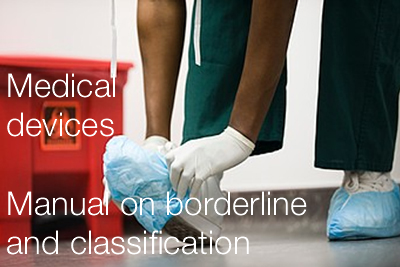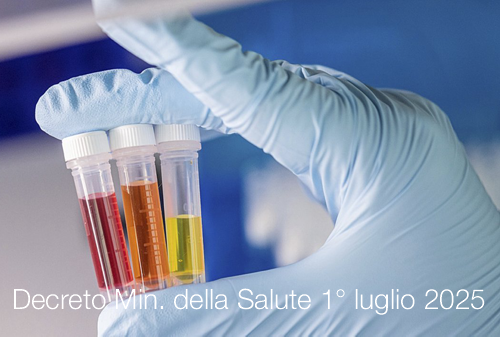
Manual on borderline and classification in the community regulatory framework for medical devices
ID 6024 | Update 08.07.2021 - Version 1.22 (May 2019)
Borderline cases are considered to be those cases where it is not clear from the outset whether a given product is a medical device, an in vitro diagnostic medical device, an active implantable medical device or not. Or alternatively, borderline cases are those cases where the product falls within the definition of a medical device but is excluded from the Directives by their scope. Where a given product does not fall within the definition of medical device or is excluded by the scope of the Directives, other Community and/or national legislation may be applicable.
Classification cases can be described as those cases where there exists a difficulty in the uniform application of the classification rules as laid down in the MDD (or where for a given device, depending on interpretation of the rules, different classifications can occur).
There may be cases where ‘claims’ of a medical nature are made for certain products, where those claims cannot be substantiated by technical, clinical and scientific data. If there is insufficient clinical, technical and scientific data to support the claims made, the product would not meet the requirements of the medical device directives and therefore may not be CE marked as a medical device. For such products no medical claim can be made.
Defining a given product as a medical device and interpretation of the application of the classification rules fall within the competence of the competent authorities of the Member States where the product is on the market.
Different interpretations of Community legislation occur, and, can put public health at risk and distort the internal market. Both issues are of great concern to Member States and the Commission. Therefore, the Commission finds it important to facilitate a dialogue among regulators and industry where diverse interpretations exist.
To this end, the working party on borderline and classification comprised of Commission services, experts of Member States and other stakeholders meet on a regular basis to discuss borderline and classification cases in order to ensure a uniform approach. The borderline and classification meeting’s primary aim is to provide for a forum to exchange opinions, and, possibly reach consensus.
This manual represents the views agreed by the regulators in this group, after a broad consultation with stakeholders, on products, or categories of products, which have raised doubts. The Commission, Member States and other stakeholders concluded that guidance is needed which goes beyond abstract rules and addresses their actual application.
However, please note that the views expressed in this manual are not legally binding, since only the European Court of Justice (“the Court”) can give an authoritative interpretation of Community law.
This manual does not relieve national competent authorities from their obligation to render decisions in these areas for any individual product, on a case-by-case basis. National authorities, acting under the supervision of the courts, must proceed on a case-by-case basis, taking account of all the characteristics of the product.
Therefore, this manual shall not “prescribe” which regulatory framework applies or how the classification rules must be applied by national authorities. Rather, it shall serve as one out of many elements supporting the national competent authorities in their case-by-case decision on individual products.
In particular, this manual does not prevent a national authority from consulting with colleagues from other regulated sectors concerned in order to reach a complete view on all aspects related to a given product.
This manual will be updated in the light of the outcomes of the discussions of the working party on borderline and classification issues.
________
INTRODUCTION
1. MEDICAL DEVICE/IN VITRO DIAGNOSTIC MEDICAL DEVICE – MEDICAL INTENDED PURPOSE
Introduction
1.1. Light box indicated to treat seasonal affective disorder (S.A.D)
1.2. AB0 and Rhesus (D) blood grouping intended for diet purposes
1.3. Pharmacy compounders
1.4. Dental disclosing products
1.5. Mixer
1.6. Non-corrective contact lenses with a medical purpose
1.7. Biofunctional clothes
1.8. System for the determination of bacterial contamination in blood products
1.9. Independent in-vivo dosimeters
1.10. Gallipots
1.11. Shoe covers
1.12. Urine Diverter / Funnel Element for Mid-Stream Urine Collection
1.13. Air purifiers / Air decontamination units / Mobile air decontamination units
1.14. Wigs and head scarves.
1.15. Blood irradiation indicators.
1.16. Odour neutralizers
1.17. Bedwetting alarm
1.18. Sweat generation and diagnostic system – status of sweat card
1.19. Products intended to reduce the effect of alcohol
1.20. Radiation shields
1.21. Rugby helmet
1.22. Autopsy saw
1.23. UV flow germicidal lamp
1.24. Water filter
1.25. Mattress covers against mites
1.26. Lubricants intended for body massages and/or sexual intercourse
1.27. Solution for adhesive bandage removal
1.28. Pill organiser boxes
2. BORDERLINE IN VITRO DIAGNOSTIC MEDICAL DEVICE
Introduction
2.1. Sample receptacles and sampling devices which are intended to be used for the collection by the lay user of samples, which are subsequently examined by third persons
2.2. CE labelled microscope slides
2.3. Single or multiple channel pipettes
2.4. Qualification of fluid collection bowl
3. BORDERLINE ACTIVE IMPLANTABLE MEDICAL DEVICE – MEDICAL DEVICE
3.1. Bone anchored hearing aids
4. BORDERLINE MEDICAL DEVICE – MEDICINAL PRODUCT
Introduction
4.1. Product for testing patient reflex cough
4.2. Elastoviscous fluids.
4.3. In-Vitro Fertilisation (IVF) and Assisted Reproductive Technologies (ART) products
4.4. Peritoneal dialysis solutions
4.5. Agents for transport, nutrition and storage of organs intended for transplantation
4.6. Zinc oxide containing creams
4.7. Eye drops intended for related to the alleviation of ‘soreness’ , ‘discomfort’ or ‘irritation’ caused by environmental factors (such as dust, heat, smoke, etc.)
4.8. Product for use in acute sore throat
4.9. Plaster with capsaicin
4.10. Gold implants for treatment of osteoarthrosis
4.11. Substances for chemical peeling
4.12. Mustard packs
4.13. Washing solutions used for pathogenic microorganisms
4.14. Mousse for rapid relief from irritation, itching, burning and sensitivity associated with chickenpox
4.15. Injectable substance for treatment of localized adiposity
4.16. Riboflavin solution for treatment of keratoconus
4.17. Dentistry products with aluminium chloride used in haemostasia
4.18. Qualification and classification of a wound gel containing soluble beta glucan
4.19. Glycerin suppositories
4.20. D-mannose for the prevention of urinary tract infections
4.21. Solution of 8-MOP in extracorporeal photochemotherapy
4.22. Bone void fillers containing animal growth factors
4.23. Weight management products
5. BORDERLINE MEDICAL DEVICE – BIOCIDES
Introduction
5.1. Hand disinfectants
5.2. Insect repellent
5.3. Multipurpose disinfectants
5.4. Brushes and sponges for washing/cleaning nails, hands and/or harms in hospitals (prior to surgery)
6. BORDERLINE MEDICAL DEVICE –COSMETIC PRODUCTS
Introduction
6.1. Tooth whitening or bleaching products
6.2. Alum styptic pencils
7. ACCESSORY TO A MEDICAL DEVICE OR AN IN-VITRO DIAGNOSTIC MEDICAL DEVICE
Introduction
7.1. Haemodialysis water test strips
7.2. Surgical instrument decontamination products
7.3. Dental Water Line Disinfectants
7.4. Sterilization indicators
7.5. Microplate washers
7.6. Automated external defibrillator storage units (Ed. 1.22 May 2019)
8. CLASSIFICATION
Introduction
8.1. Light box indicated to treat seasonal affective disorder (S.A.D)
8.2. Oxygen delivery
8.3. Examination gloves coated with polyhexamethylene biguanide (PHMB)
8.4. Picture Archiving and Communication Systems (PACS)
8.5. Blood refrigerators, freezers and defrosters
8.6. Warming blankets
8.7. Products evaluating the condition of respiratory muscles
8.8. Neutral electrodes for high frequency surgery
8.9. Surgical instrument decontamination products
8.10. Dental water line disinfectants
8.11. Dental curing lights
8.12. Bacterial/viral filter for use on patient undergoing pulmonary function testing
8.13. Hydrocolloid plaster for blisters
8.14. Movement monitor for babies
8.15. Medical devices containing silver
8.16. Ethyl chloride spray for local refrigeration anaesthesia
8.17. Pathogen inactivation system for platelets
8.18. Pre-transfusion confirmatory tests
8.19. Eye drops regulated as medical devices
8.20. Wound irrigation solutions containing antimicrobial agents
8.21. Contact lenses.
8.22. Paraffin oil for IVF/ART procedure
8.23. Dental abutments
8.24. Autologous Platelet Preparation System
8.25. Antimicrobial Photodynamic Therapy (APDT) systems
8.26. Tissue expanders used in the breast
8.27. Dura guard for use with a craniotome
8.28. Heart bypass cannulae
8.29. Liquid nitrogen for cryopreservation of cells and tissues of human origin for medical purpose
8.30. Whole body and partial body cryotherapy chambers
8.31. Trial hip prosthesis heads or stems
8.32. Lubricants intended for alleviation of vaginal dryness (Ed. 1.22 May 2019)
9. SOFTWARE AND MOBILE APPLICATIONS
Introduction
9.1. A mobile application for processing ECGs
9.2. A mobile application for the communication between patient and caregivers while giving birth
9.3. A mobile medical application for viewing the anatomy of the human body
9.4. Qualification of software for interpretation of a guideline
9.5. Qualification and classification of software for delivery and management of cognitive remediation and rehabilitation programs
9.6. Classification of software for information management and patient monitoring
9.7. Mobile application for managing pictures of moles
9.8. Mobile application for the assessment of moles
9.9. Product intended to facilitate conception based on basal body temperature
9.10. Product intended to facilitate conception and enable contraception based on basal body temperature
9.11. Stand-alone software application for conception and contraception purposes using data entered by the patient
9.12. Medication decision support software (Ed. 1.22 May 2019)
10. APPENDIX
Fonte: EC
Versioni
| 1.19 |
Aprile 2018 |
Manual on borderline and classification in the community regulatory framework for medical devices |
| 1.20 |
Ottobre 2018 |
Manual on borderline and classification in the community regulatory framework for medical devices |
| 1.21 |
Gennaio 2019 |
Manual on borderline and classification in the community regulatory framework for medical devices |
| 1.22 |
Maggio 2019 |
Manual on borderline and classification in the community regulatory framework for medical devices |
Collegati:
Allegati
|
Descrizione |
Lingua |
Dimensioni |
Downloads |
 |
|
EN |
523 kB |
14 |
 |
|
EN |
1108 kB |
14 |
 |
|
EN |
869 kB |
17 |
Allegati
|
Descrizione |
Lingua |
Dimensioni |
Downloads |
 |
|
EN |
1115 kB |
17 |



































